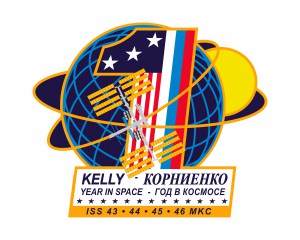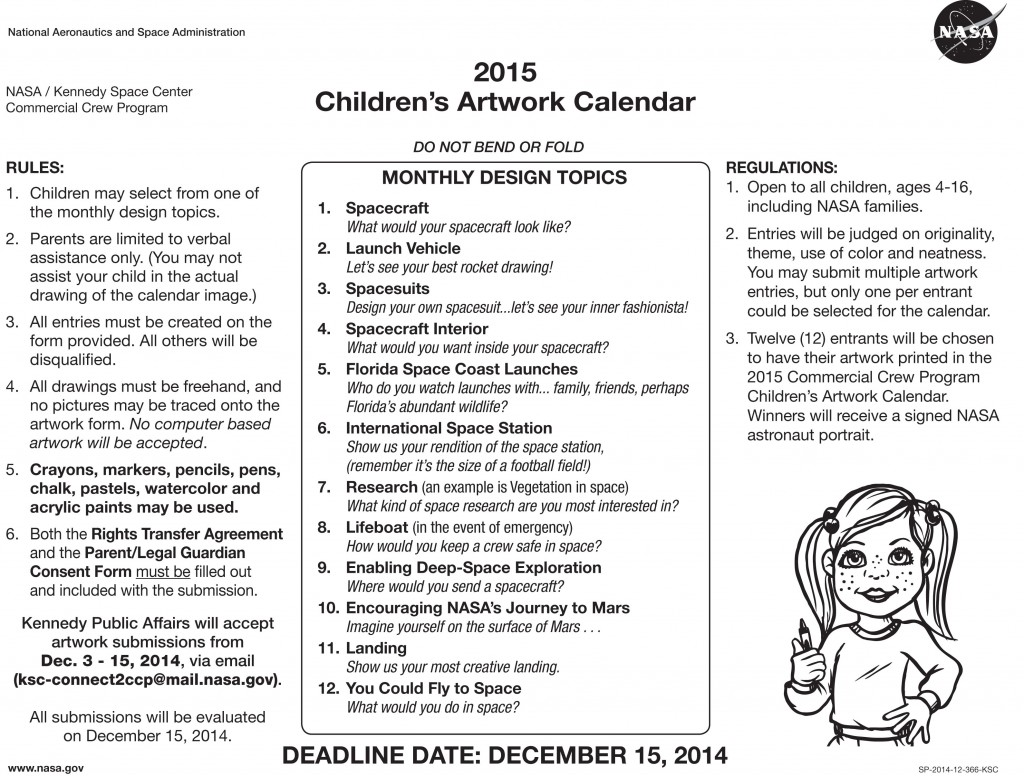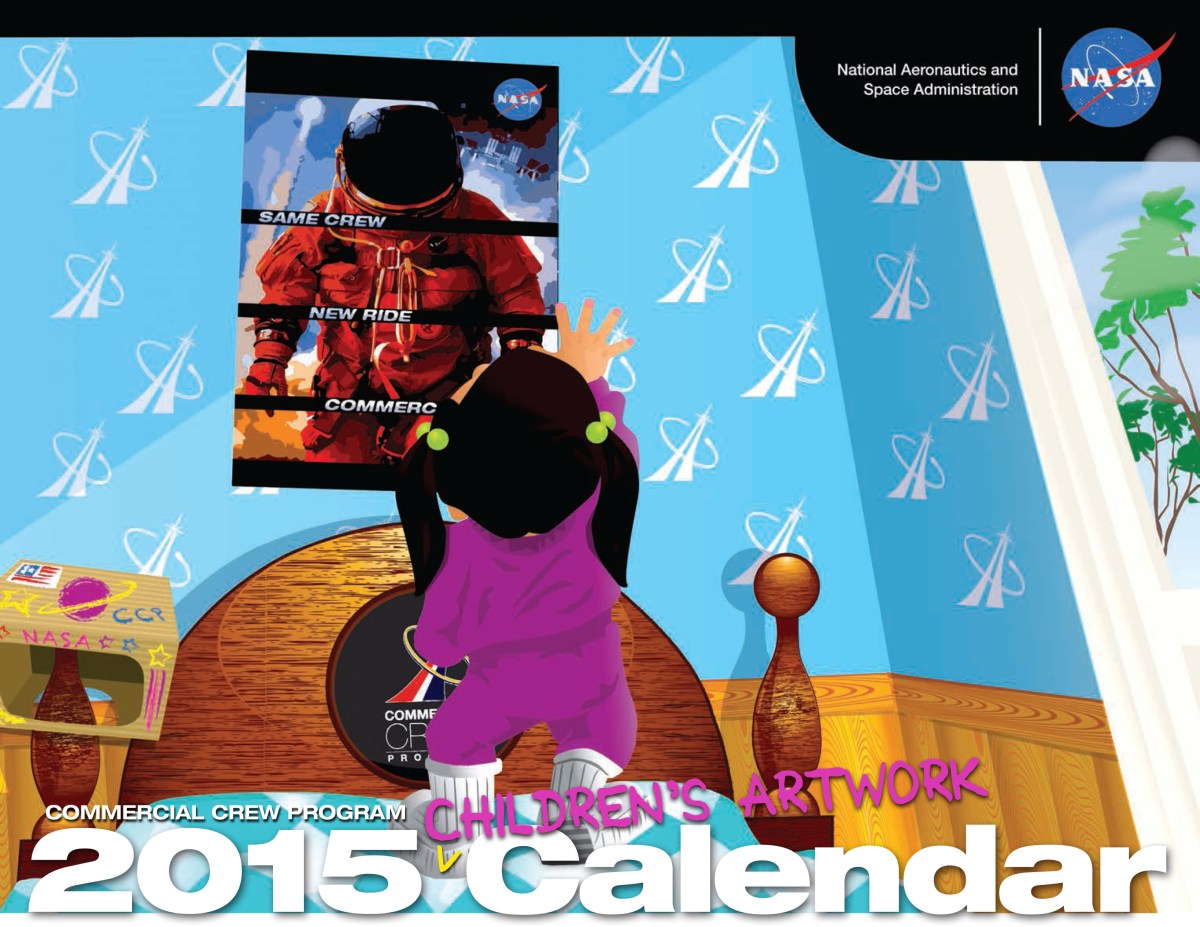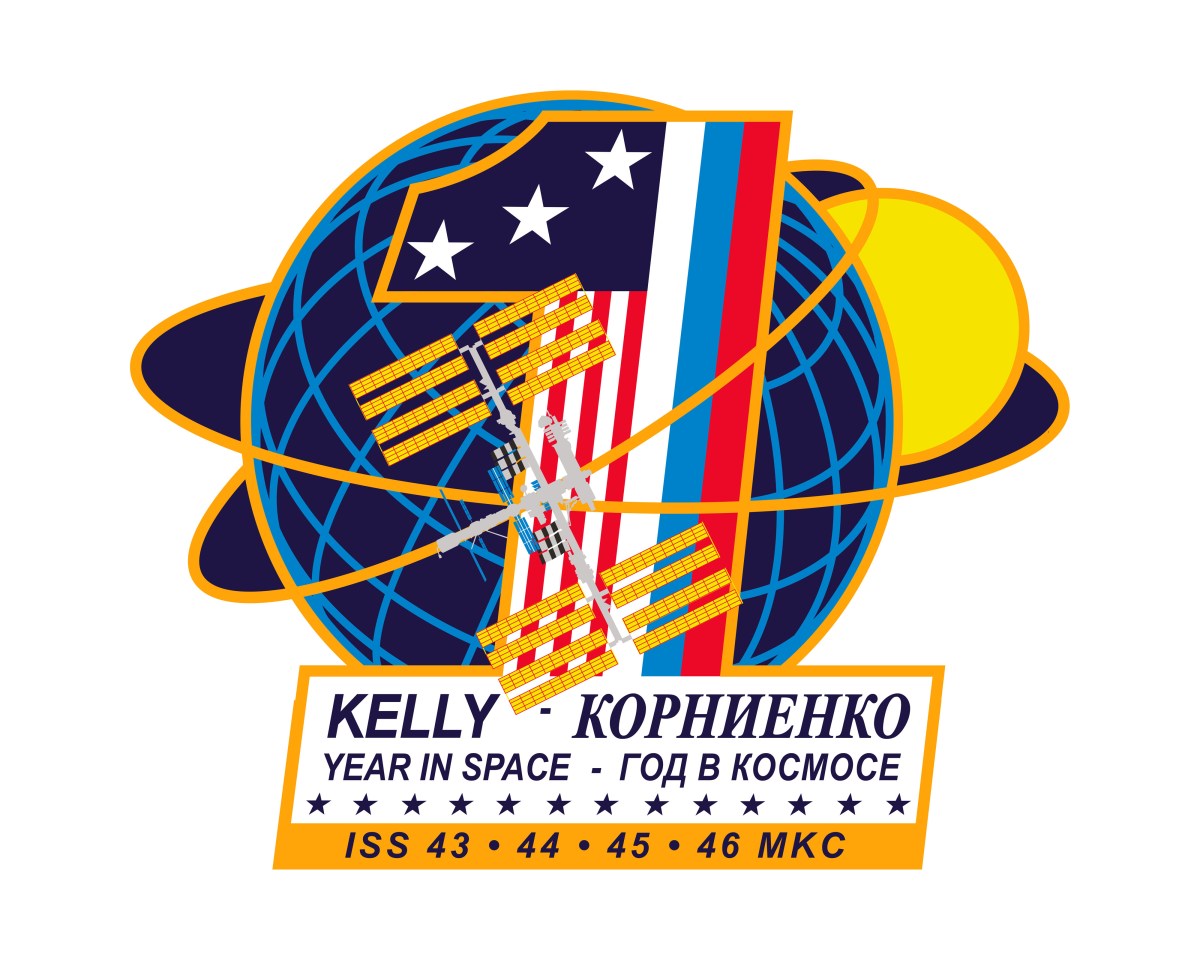 Just in time for the new year, here is the Commercial Crew Program 2015 Children’s Artwork Calendar. More than 50 students, ages 4-16, submitted artwork depicting human spaceflight as they see it in the December contest. A range of topics was offered and students from across the country sent in submissions. We offer a huge “thank you!” to everyone who submitted their work and hope that everyone will enjoy and use this calendar next year. Thanks for a great 2014! Download and print the calendar here.
Just in time for the new year, here is the Commercial Crew Program 2015 Children’s Artwork Calendar. More than 50 students, ages 4-16, submitted artwork depicting human spaceflight as they see it in the December contest. A range of topics was offered and students from across the country sent in submissions. We offer a huge “thank you!” to everyone who submitted their work and hope that everyone will enjoy and use this calendar next year. Thanks for a great 2014! Download and print the calendar here.
NASA Commercial Crew Partners Complete 23 Milestones in 2014, Look Ahead to 2015
 NASA’s Commercial Crew Program and the agency’s industry partners completed 23 agreement and contract milestones in 2014 and participated in thousands of hours of technical review sessions focused on creating a new generation of safe, reliable and cost-effective crew space transportation systems to low-Earth orbit destinations. Read more about this year’s milestones and achievements and what we have to look forward to in 2015 as we work to bring crewed launches back to the U.S. http://go.nasa.gov/1AQKBCY
NASA’s Commercial Crew Program and the agency’s industry partners completed 23 agreement and contract milestones in 2014 and participated in thousands of hours of technical review sessions focused on creating a new generation of safe, reliable and cost-effective crew space transportation systems to low-Earth orbit destinations. Read more about this year’s milestones and achievements and what we have to look forward to in 2015 as we work to bring crewed launches back to the U.S. http://go.nasa.gov/1AQKBCY
Getting to Space Isn’t Easy, But It’ll Be More Automated
Since the beginning of the space age, finding the balance of control between human and machine has been a careful pursuit. Thanks to advances in technology and software, Commercial Crew spacecraft will be will be more automated than any that have come before. Learn more: http://go.nasa.gov/1Cw7Weq
SpaceX Completes First Milestone for Commercial Crew Transportation System
 SpaceX’s has completed its first milestone in the company’s path toward launching crews to the International Space Station from U.S. soil under a Commercial Crew Transportation Capability contract with the agency.
SpaceX’s has completed its first milestone in the company’s path toward launching crews to the International Space Station from U.S. soil under a Commercial Crew Transportation Capability contract with the agency.
During the Certification Baseline Review, SpaceX described its current design baseline including how the company plans to manufacture its Crew Dragon spacecraft and Falcon 9 v.1.1 rocket, then launch, fly, land and recover the crew. The company also outlined how it will achieve NASA certification of its system to enable transport of crews to and from the space station.
Read the details here: http://go.nasa.gov/13lwR7K
The Future, One Year at a Time
 NASA astronaut Scott Kelly and Russian cosmonaut Mikhail Kornienko will set off in a Soyuz in March 2015 for a one-year expedition living aboard the International Space Station. The goal of their yearlong stay is to understand better how the human body reacts and adapts to the harsh environment of space.
NASA astronaut Scott Kelly and Russian cosmonaut Mikhail Kornienko will set off in a Soyuz in March 2015 for a one-year expedition living aboard the International Space Station. The goal of their yearlong stay is to understand better how the human body reacts and adapts to the harsh environment of space.
When Kelly and Kornienko return to Earth in 2016, America will be about a year out from having two certified systems capable of transporting crews to and from the station – Boeing’s CST-100 and SpaceX’s Crew Dragon. These Commercial Crew vehicles will become part of the station’s fleet of human-rated systems. The vehicles will carry a fourth crew member to the station who can focus on collecting scientific data important to future human exploration of our solar system.
Both efforts offer a dawn of discovery in paving the way for journeys around the moon, an asteroid and ultimately Mars. The yearlong mission will prepare astronauts for such voyages in the future, and Commercial Crew will play its part so other machines can be developed for the demands of travel beyond low-Earth orbit.
Boeing Covers Groundwork in Second Milestone
The momentum of certifying American space transportation systems capable of carrying astronauts to the International Space Station continued on pace as NASA took a comprehensive look at all of Boeing’s ground-based system designs. This Ground Segment Critical Design Review marks the second milestone in the company’s Commercial Crew Transportation Capability (CCtCap) contract, NASA’s Launch America initiative designed to return human spaceflight launches to the United States and end our reliance on Russia. http://go.nasa.gov/1GkQx8G
Never Too Young to Wonder
 Art has been a central element in achieving the dream of spaceflight because it starts the imagination down a path from simple concept to complex design. So young explorers, this is your chance to show what you think space travel and exploration should be.
Art has been a central element in achieving the dream of spaceflight because it starts the imagination down a path from simple concept to complex design. So young explorers, this is your chance to show what you think space travel and exploration should be.
As we can see from 7-year-old Evelyn of Titusville, space exploration should make us happy as we send people to push the boundaries of knowledge and experience, opening new doors for discovery along the way. Kids, show us what you think space exploration should look like, from rockets to spacecraft and research projects. The best works will be featured in a special 2015 calendar. This contest is open to anyone ages 4 to 16, and everything you need to fill out and work with is here.
Calling All Young Artists
For decades, artists have conveyed the hope and sense of wonder of human space exploration. Think Normal Rockwell’s oil painting depicting astronauts John Young and Gus Grissom suited up for the first flight of NASA’s Gemini Program, Fred Freeman’s acrylic painting of the Saturn Blockhouse and even Apollo astronaut turned artist Alan Bean. And some of the best works of art come from children who are only limited by their imaginations. Take, for example, this gem that we received during our 2015 Commercial Crew children’s artwork calendar competition. Eleven-year-old Evan from Palm Bay, Fla., conveys the drama of exploring our solar system with a mix of art and music . . . da . . . da . . da . . . dum . . . da . . . da . . . da . . . dum . . .
Any young explorer, age 4 to 16, can enter the competition until Dec. 15, including NASA families. Download everything you need to know to enter here.
Hey Kids – Contribute to the 2015 Commercial Crew Calendar!
NASA’s Commercial Crew Program wants you to help draw out our future in space exploration! We’re going to put out a calendar for 2015 in a few weeks and it will be up to you to decide how it will look. The best thing is that it will be really easy, and you could see your work featured on the Commercial Crew Website! (*This contest is open to all children ages 4 to 16 regardless of NASA affiliation)

We have some rules for submitting your drawings, so you’ll have to print out a few forms then fill them out with your parent’s help, scan them to send them back to us via email at ksc-connect2ccp@mail.nasa.gov. We’re also including a template for you to draw on, which will help us lay out the calendar.
We’re looking for the best drawings in 12 categories, so get out your art tools and let your imagination fly through space with us! One last thing: the deadline for submissions is Dec. 15 at noon Eastern. Now the fun stuff, the categories . . .
1. Spacecraft: NASA’s spacecraft of the past had thousands of nobs and dials. Today’s commercial crew spacecraft will use touch screens, 3D printed seats and engines, and will be lightweight, but tough enough to withstand meteorites. What would your spacecraft look like?
2. Launch Vehicle: The commercial crew rockets that will carry astronauts to the International Space Station will be smaller than NASA’s previous Saturn V and space shuttle systems. Their missions are different, so their capabilities are different. Think of it like riding your bike to see your next-door neighbor, instead of driving a semi-truck on a cross-country trek. Let’s see your best rocket drawing!
3. Spacesuits: An astronaut’s spacesuit is like his or her own personal spacecraft. Commercial crew spacesuits will keep astronauts safe by providing breathable air and a cool temperature. They also will enable constant communication with people monitoring their health here on the ground. Design your own spacesuit . . . let’s see your inner fashionista!
4. Spacecraft Interior: Every spacecraft’s interior has been unique and advanced for its time. Apollo was very different from the space shuttle, and both are very different from the commercial crew systems that astronauts will use to fly to the International Space Station. Today’s spacecraft could feature tablet-like technology, 3D printed seats, Wi-Fi and much more. What would you want inside your spacecraft?
5. Florida Space Coast Launches: The rumble . . . the glow . . . the excitement! Every time NASA has launched people off the surface of Earth and into space, it has been from Florida’s Space Coast. In the next couple years, we will see commercial crew engines glow orange and plumes of smoke as astronauts again launch to the International Space Station from Florida. In the 2030s, we will also see astronauts launching from Florida’s Kennedy Space Center as they begin their journey to Mars. Who do you plan to watch launches with? Family, friends, perhaps Florida’s abundant wildlife?
6. International Space Station: Look up! The International Space Station is orbiting about 250 miles above the surface of Earth, 24 hours a day, seven days a week, 365 days a year. On board, astronauts conduct ground-breaking research that helps us here on Earth. They also are learning what it takes to live for long periods of time in space, which will help them on their journey to Mars. Commercial crew will help add an additional crew member to the station, essentially doubling the research potential of today. Show us your best rendition of the space station, remember it’s the size of a football field!
7. Research: Every day, astronauts perform research aboard the International Space Station, which is commercial crew’s ultimate destination. That research makes our lives better here on Earth, helps us understand more about our own planet and prepares us for longer missions to Mars. What kind of space research are you most interested in?
8. Lifeboat: Similar to lifeboats on a cruise ship, commercial crew spacecraft that will fly astronauts to the International Space Station are designed to safely and quickly evacuate the station’s crew in an emergency. How would you keep a crew safe in space?
9. Enabling Deep-Space Exploration: Commercial crew spacecraft will go to the International Space Station about 250 miles above Earth. But the solar system has hundreds of other interesting places, too! Future astronauts could use other spacecraft to explore asteroids that are close enough to Earth, or maybe even a comet. Where would you send a spacecraft
10. Encouraging NASA’s Journey to Mars: By encouraging private companies to provide human transportation services to and from low-Earth orbit – a region NASA’s been visiting since 1962 – America’s space agency will get the most research and experience out of the nation’s orbiting laboratory. Commercial crew allows NASA to expand its focus to build spacecraft and rockets for flights to Mars. Imagine yourself on the surface of Mars . . .
11. Landing: Spacecraft landings are quite impressive. After flying through space and re-entering the atmosphere at 17,500 miles per hour, spacecraft have to land smoothly to protect the astronauts and scientific research they carry. Commercial crew spacecraft designers are looking at options to land with parachutes and airbags, fly to a runway, similar to an airplane, or land using only rocket engines. Show us your most creative landing.
12. You Could Fly to Space: Remember when only astronauts could go to space? NASA won’t be the only customer for new commercial crew spacecraft. Companies will own and operate their crew transportation systems and be able to sell services to other customers . . . will you be one of them? What would you do in space?
And here’s all you need to get started: CCP-Planner-Artwork-Form_final
SNC Tests Dream Chaser Propulsion System
Sierra Nevada Corporation, one of NASA’s Commercial Crew Program partners through the agency’s Commercial Crew Integrated Capability (CCiCap) initiative, recently performed incremental tests of its reaction control system, which will help maneuver its Dream Chaser spacecraft in space. The company’s Milestone 15a built on SNC’s previous propulsion system development efforts by implementing a compact prototype thruster operating in a vacuum chamber to simulate an on-orbit environment.






